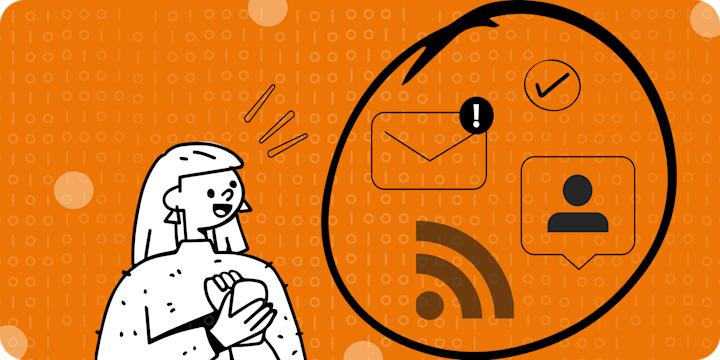An RSS feed: an intimidating name for a much less intimidating tool. In short, an RSS feed takes data from all sorts of sources- social media, blogs, news sites - and puts all of your favorite tidbits into a easy access dashboard. Oftentimes people get turned away by the technical coding nature, but we promise that anyone can take advantage of this helpful aggregation system.
In this ultimate guide to understanding, using, and automating RSS Feeds, we will cover all the RSS knowledge you need to know. Whether you have an extensive coding background or none at all, RSS feeds are not something to shrug off. Instead, we hope to display how RSS feeds and IFTTT can help revolutionize the way you catch up on important information.
IFTTT, or "If This Then That," is our easy-to-use automation service that allows you to automate RSS feeds and connect them to 1000+ other apps and services. So, what are you waiting for? Join today and see for yourself why IFTTT is trusted by over 30 million users.
What is an RSS Feed?
An RSS Feed (Really Simple Syndication) is a type of web feed that enables users to quickly access a web page's content without having to browse multiple websites. Instead of checking your favorite social medias and news sites for information, an RSS feed can compile all these into one convenient space.
An RSS allows websites and major blogs to broadcast their content in an organized manner, which can then be "fed" into a reader or news aggregator program. This makes it easy for users to keep up with the latest news, updates, and other information from their favorite sites all in one place.
RSS feeds are generally formatted using XML code, which gives them a consistent look and feel across different digital platforms. This makes them easily recognizable no matter where they appear online. RSS feeds also usually contain summaries of content along with links back to the source website so readers can easily access more detailed information if needed. Additionally, RSS feeds often contain metadata about the content such as the author's name, publication date, keywords, and so on.
What are the benefits of RSS feeds?
Since an RSS link provides users with summaries of content from multiple sources, they are incredibly useful for keeping up with news from various sources all in one place. They also make it easier for people to organize and manage their subscriptions by sorting through the feeds according to their interests or preferences.
Additionally, RSS feeds can be set up within automated systems to deliver updates directly from sources as soon as they become available — eliminating the need for users to search for new content on their own.
Lastly, many companies use RSS feeds as part of their marketing strategies by including subscription links on their websites or offering special promotions via RSS Feeds.
Are RSS feeds still used in 2025?
Yes, RSS feeds are still widely used in 2025, and are not outdated. They provide a convenient and efficient way of keeping up to date with the latest news and developments from multiple sources without having to search through each individual website separately.
RSS feeds offer readers a streamlined approach to content delivery that is both reliable and customizable. Many brands, such as Feedly and WordPress, use complex RSS Feeds to make their tools work.
With RSS, users can easily customize their subscriptions by adding, removing, or reorganizing their favorite news sources. Additionally, they can set up automated systems to deliver updates as soon as they become available. This makes it easier than ever for users to stay informed about the topics that matter most to them with minimal effort on their part.
Furthermore, businesses continue to leverage RSS feeds as part of their marketing strategies by including subscription links on their websites or offering special promotions via RSS feeds. This allows them to reach larger audiences while still targeting highly engaged customers who are likely interested in what they are offering.
RSS technology has actually advanced quite a bit since its beginnings in 1999 and now supports several new features such as full-text articles, podcasting capabilities, file downloads, and more. With such advancements, it's no surprise that RSS feeds continue to be popular in 2025 and will likely remain so for years to come.
Key RSS feed updates:
- Full-text article delivery
- Podcast integration
- File downloads
- Rich media content
- Social media updates
Why should I subscribe to an RSS feed?
Subscribing to an RSS feed can provide a number of benefits for those looking to stay up-to-date with the latest news, updates, and other information from their favorite websites.
Convenience and organization: Subscribing to a site's RSS feed allows users to quickly access content without having to manually search through multiple websites. This makes it much easier to keep up with the latest content from all of your favorite sites in one convenient place. Additionally, RSS feeds enable users to organize and manage their subscriptions by sorting through the feeds according to their interests or preferences.
Quicker information: RSS feeds can be set up within automated systems so that they deliver updates directly from sources as soon as they become available. This eliminates the need for users to search for new content on their own and ensures that they always have access to the most recent information as soon as it is published.
Marketing boost: Many companies use RSS feeds as part of their marketing strategies by including subscription links on their websites or offering special promotions via RSS feeds. By subscribing to a company’s RSS feed, customers can take advantage of exclusive offers and be among the first people to know about new products or services being released by that company.
Overall, RSS feeds make it much easier for web users to stay informed about current topics and trends without having to visit multiple sources in order to do so. Through automated technology, these feeds deliver timely summaries with links back to the source website whenever something new has been posted — ensuring that subscribers never miss out on any important updates.
Types of content you might subscribe to with RSS feeds:
How to use RSS feeds: step-by-step guide
1. Choose an RSS feed reader
Select from popular RSS feed readers such as:
2. Find RSS feeds to follow
Look for the RSS icon (usually orange) on websites
Use the website's URL + "/feed" or "/rss"
Check the website's footer for RSS links
Use browser extensions to detect RSS feeds
3. Add feeds to your reader
Copy the RSS feed URL
Open your chosen RSS reader
Click "Add Content" or "Subscribe"
Paste the RSS feed URL
Organize feeds into categories
How to automate RSS feeds using IFTTT
IFTTT, short for "If This Then That," is our free unique service that can enhance your news and media aggregation process. IFTTT can create powerful automated actions based on time, events, and triggers from a variety of organization and code tools.
IFTTT is designed to boost productivity by automating tasks. It works by creating connections between over 1000 popular apps and services, allowing them to work together seamlessly. Best of all, you don't need any coding background to start with our user-friendly platform.
Here are some of our favorite ways to use an RSS Feed with IFTTT
Automate your social media posts
Keep your website visitors informed
For the ultimate feed reader
Update your note-taking apps
Other popular ways to automate RSS feeds
-
RSS to Diigo

-
Rss To Trello
-
Post new RSS feed items to Blogger
-
Add a Toodledo task for new RSS feed items
-
RSS To Tumblr
-
Post new RSS feed items to WordPress automatically
-
Post to a channel when new articles appear in the RSS Feed you choose

-
Discord Status
Join IFTTT
Founded in 2010, IFTTT has been used by over 30 million individuals to automate both business and home tasks. It's commonly used to connect services and systems, making all products and services work well together. Best of all, it's free to start and only takes a couple of minutes to set up.
Join IFTTT today to automate your RSS feeds!



